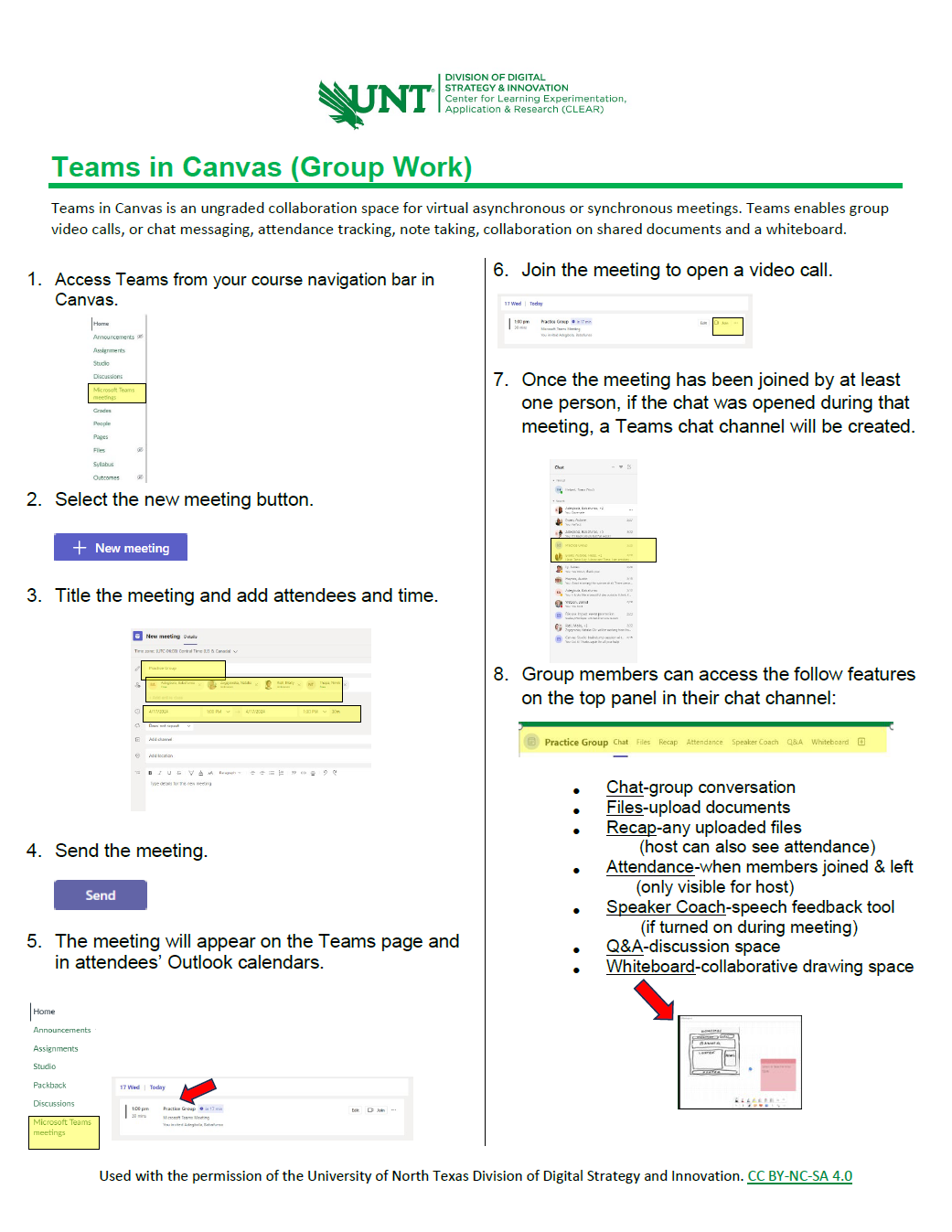Group Work in Higher Education: Benefits & Practices for Success
- DSI CLEAR
- Teaching Resources
- Theory & Practice
- Methods for Continuous Improvement
- Using AI in the Higher Education Classroom
- Invisible Labor and Faculty Retention Since COVID-19
- Inclusive Discussions
- Inclusive Assessment
- Designing Assessments for Academic Integrity
- Inclusive Instructional Strategies
- Instructor Presence in the Online Classroom
- Tips for Providing Personalized Feedback to Students
- Course Design for Student Retention
- UNT's CLAW 3 Active Learning Classroom Instructional Guide
- UNT Faculty Teaching & Learning Resource Guide
- Growth Mindset in the Higher Education Classroom
- Course Outcomes & Objectives
- Multimedia Course Design for Student Engagement and Retention
- Level Up Learning With Portfolios
- Group Work in Higher Education: Benefits & Practices for Success
- Open Educational Resources & Copyright Essentials for Instructors
- Evaluating OER Resources
- Accessibility Online
- Copyright Guide
- Online Teaching
- UNT Syllabus Template
- Teaching Consultation Request
- Open Educational Resources & Copyright Essentials for Instructors
- Evaluating OER Resources
 Group Work in Higher Education: Benefits & Practices for Success
Group Work in Higher Education: Benefits & Practices for Success
Collaborative learning, also known as group work, is a pedagogical approach that fosters student interaction, shared knowledge construction, and cooperative problem-solving (Almazovaite et al., 2024; Heilporn et al., 2021). It specifically refers to structured, instructor-guided activities in which students share responsibilities and engage in curriculum collectively (Medaille & Usinger, 2020). Recent research highlights its effectiveness in enhancing cognitive development, social skills, and academic achievement. This review examines these benefits while also discussing essential factors for designing and implementing group work effectively in higher education.
Benefits of Collaborative Learning
- Fairness: Although group work offers numerous benefits, both faculty and students often express concerns about the fairness of assessment and equal contribution in group assignments. Group assignments that implement peer and self-assessment foster an increased sense of fairness, accountability, and trust amongst group members (Ion, Díaz-Vicario, & Mercader, 2024). While instructors can design assessments to align with their expectations and the nature of the assignment, utilizing established assessment tools is also a great option.
- The Peer Assessment Collaboration Evaluation (PACE) tool is a web-based tool designed to combat social loafing in online group assignments. Based on a Likert-type scale, PACE measures the quality of work, quality of contribution, timeliness, related knowledge, and interaction/communication. It is freely available for integration into learning management systems (LMSs) such as Canvas. A recent study examining the impact of the PACE assessment on students' attitudes toward group work found that using the tool enhanced their perception of its usefulness and ease of use while also influencing their behavioral control and self-efficacy during the project (Havard et al., 2023).
- The Groups Advance into Teams Enabling Success (GATES) tool is an evidence-based tool used by allied health universities to integrate core teaching principles into online group assessment (Singleton et al., 2022). The elements evaluated through this tool include team structure, communication, leadership, and situational monitoring/mutual support.
- Barriers due to Language Proficiency: UNT is the home of about 9,000 international students coming from 137 countries (UNT, n.d.). While students are required to demonstrate proof of English Proficiency to be admitted into UNT, these students may still face barriers in language proficiency when working with students who speak English as their first language. A qualitative study examining international students' experiences in a business writing course, found that asynchronous collaborative discussion board assignments enhanced their sense of belonging during group work (Chen, 2023). The flexibility of these asynchronous assignments allowed international students extra time to prepare their contributions, increasing their confidence in their ability to participate actively in group work.
- Introversion: Every student is unique, leading to a wide range of introverted and extroverted tendencies among students that may surface during group work. A recent study examined the experiences of third- and fourth-year college students that self-identify as quiet students. These students reported they were often uncomfortable in group learning environments due to a perceived pressure to demonstrate their learning (Medaille & Usinger, 2020). This discomfort often resulted in a lack of engagement in the activity, and in some cases even brought on behaviors aimed at avoiding the situation entirely. When asked what contributed to these students' silence during small group discussions, their answers pointed to the fact that there was often little time to get comfortable with their peers before being asked to collectively engage with the material. Allowing time for relationship building activities in collaborative learning may serve to mitigate this challenge, giving the group members an opportunity to establish trust and productive communication patterns.
Application
Are you interested in using collaborative learning in your classroom but unsure of where to start? A recent study tracked the use of collaborative learning in both undergraduate and graduate courses offered in an online, hybrid and in person setting. This study found that collaborative learning techniques listed below helped students across multiple teaching modalities master student learning outcomes (Kuwabara et al., 2020).
- Affinity Grouping: Have students reflect on a topic individually, group them by similar ideas, and then have them work together in small groups to explore and share their insights with the class.
- Jeopardy Reviews: Students work in teams to answer questions about course material, promoting teamwork and reinforcing learning in an interactive, game-like format.
- Jigsaw: Divide a topic into sections, assigning each student a section to master, then have them come together in small groups to share and discuss what they've learned.
- Learning Cell: Have students pair up to share what they've learned and ask each other questions to reinforce their understanding.
- Note Taking Groups: Have students work together to compare and discuss their notes to deepen understanding and fill in gaps in their knowledge through collaboration.
- Peer Editing: Have students review and provide feedback on each other's work to improve it through constructive criticism and help the grader apply what they have learned by evaluating their peers' work.
- Round Robin: Have students in small groups take turns sharing their ideas or answers to a question, rotating around the group until everyone has contributed.
- Round Table Discussions: Have students sit in small groups and take turns sharing ideas or answers, creating a flexible, open discussion without a set speaking order.
- Team Matrix: Have students work in small groups to complete tasks by dividing responsibilities based on their strengths, encouraging teamwork and accountability.
- Test Taking Groups: Have students work in groups to discuss and answer test questions, promoting creative problem solving and group learning.
- Think-Pair-Share: Have students think about a question individually, pair up to discuss their thoughts, and then share their ideas with the class.
Through incorporating collaborative learning into their coursework, faculty can enhance student engagement, teamwork, and academic success in their class. While effective, factors such as fair assessment, language inclusivity, and student social dynamics should be considered when designing collaborative assignments. When thoughtfully designed, collaborative learning creates an interactive and enriching educational experience for students.
References
Almazovaite, M., Cohn, E. P., & Kumar, S. (2024). Group projects as spaces for leadership development in the liberal arts classroom: A case of american undergraduate students. Paper presented at the Frontiers in Education, , 9 1480929. https://doi.org/10.3389/feduc.2024.1480929.
Cheang, M., & Yamashita, G. L. (2023). Employers’ expectations of university graduates as they transition into the workplace. Education, 6(2). https://doi.org/10.2478/ejed-2023-0013
Chen, X. (2023). Online collaboration tools and international students' sense of belonging in group work. Journal of Teaching and Learning with Technology, 12, 105–119. https://doi.org/10.14434/jotlt.v12i1.36325
Havard, B., Podsiad, M., & Valaitis, K. (2023). Peer assessment collaboration evaluation: An innovative assessment tool for online learning environments. TechTrends, 67(2), 331–341. https://doi-org.libproxy.library.unt.edu/10.1007/s11528-022-00832-8
Heilporn, G., Lakhal, S., & Bélisle, M. (2021). An examination of teachers’ strategies to foster student engagement in blended learning in higher education. International Journal of Educational Technology in Higher Education, 18(1), 25. https://doi.org/10.1186/s41239-021-00260-3
Ion, G., Anna Díaz-Vicario, & Mercader, C. (2024). Making steps towards improved fairness in group work assessment: The role of students’ self- and peer-assessment. Active Learning in Higher Education, 25(3), 425–437. https://doi.org.libproxy.library.unt.edu/10.1177/14697874231154826
Kuwabara, M., Einbinder, S. D., Sun, R., & Azizi, R. (2020). Collaborative learning techniques, student learning outcomes, and equal workload within groups in different teaching modalities. International Journal of Teaching and Learning in Higher Education, 32(2), 293–304. https://files.eric.ed.gov/fulltext/EJ1286478.pdf
Medaille, A., & Usinger, J. (2020a). “That’s going to be the hardest thing for me”: Tensions experienced by quiet students during collaborative learning situations. Educational Studies, 46(2), 240–257. https://doi.org/10.1080/03055698.2018.1555456
Mertz, P. S., Sherrer, S. M., & Bowers, G. M. (2022). Teaching collaboration skills to undergraduate biochemistry and chemistry students. The FASEB Journal, 36. https://doi.org/10.1096/fasebj.2022.36.S1.R1949
Micari, M., & Pazos, P. (2021). Beyond grades: Improving college students’ social-cognitive outcomes in STEM through a collaborative learning environment. Learning Environments Research, 24(1), 123–136. https://doi.org/10.1007/s10984-020-09325-y
Singleton, J. A., Watson, K. E., & Kenyon, J. J. (2022). GATES: An online step-wise tool to develop student collaborative teamwork competencies. Innovative Higher Education, 47(1), 23–43. https://doi.org/10.1007/s10755-021-09569-3
